
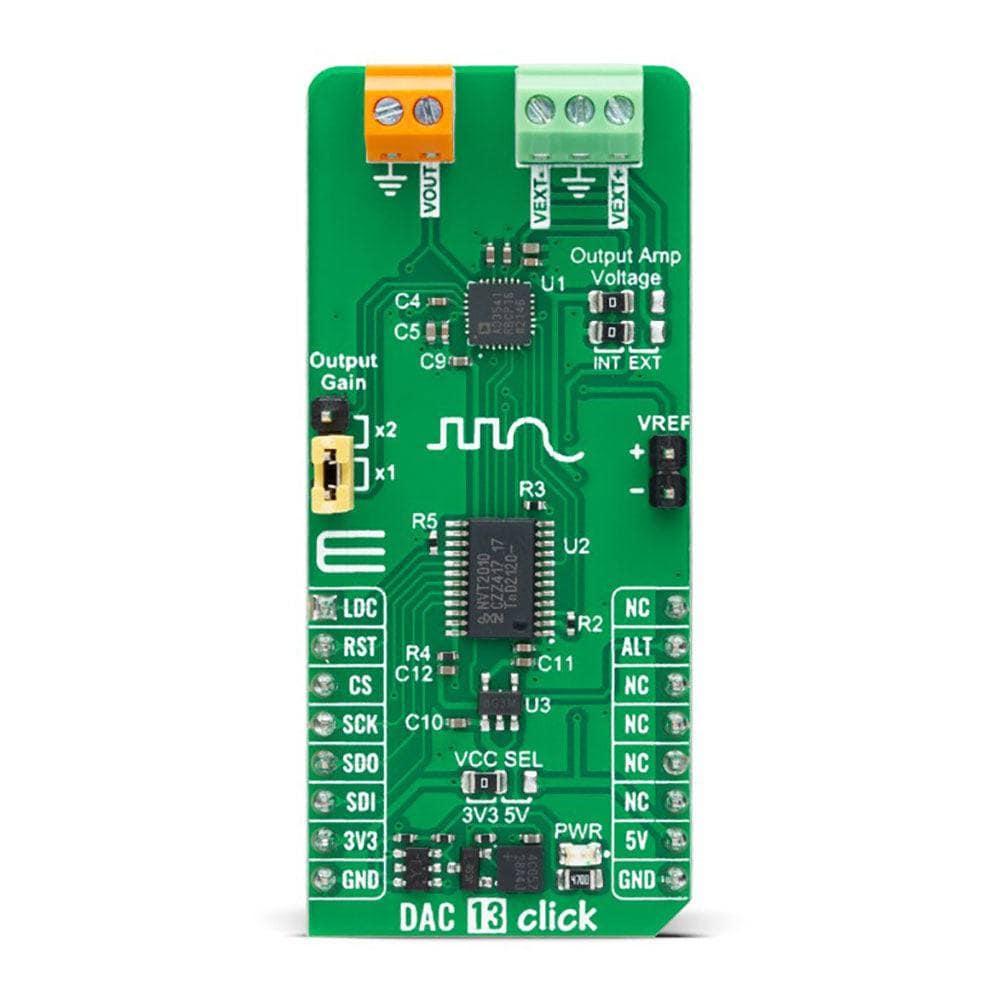
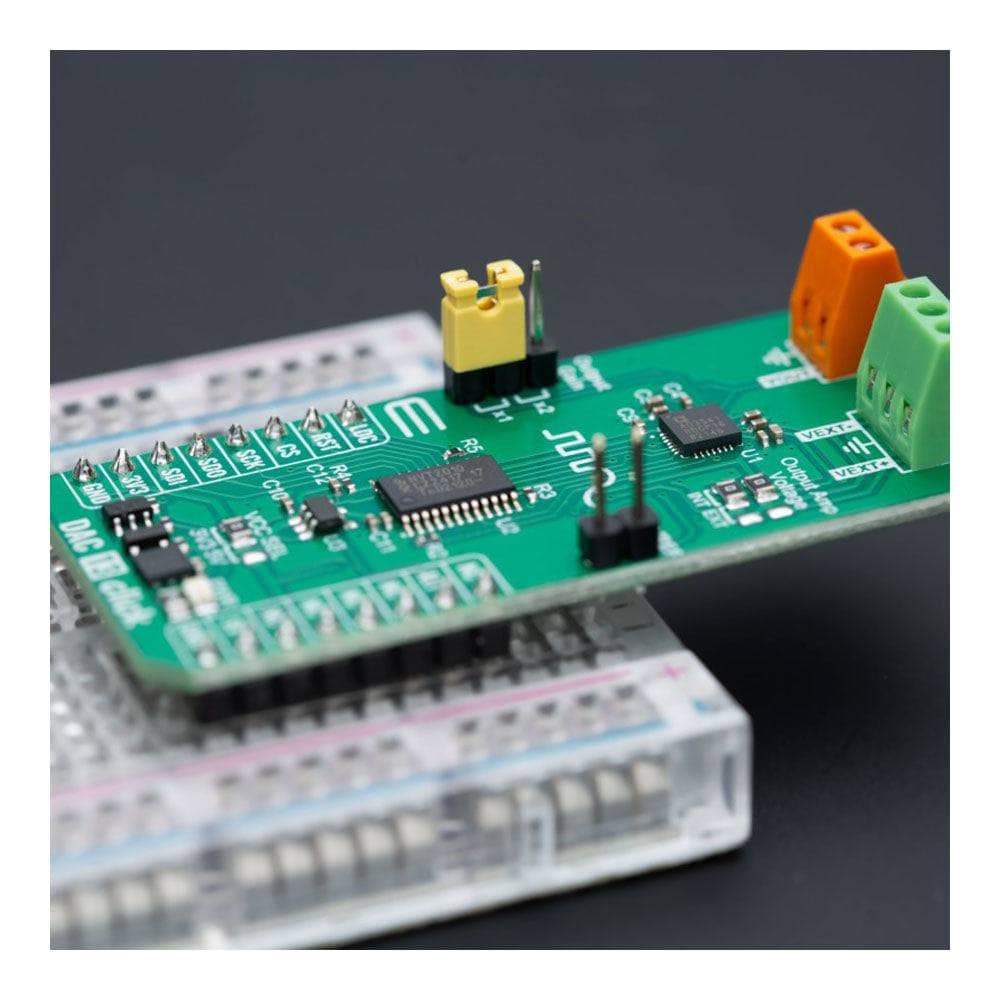
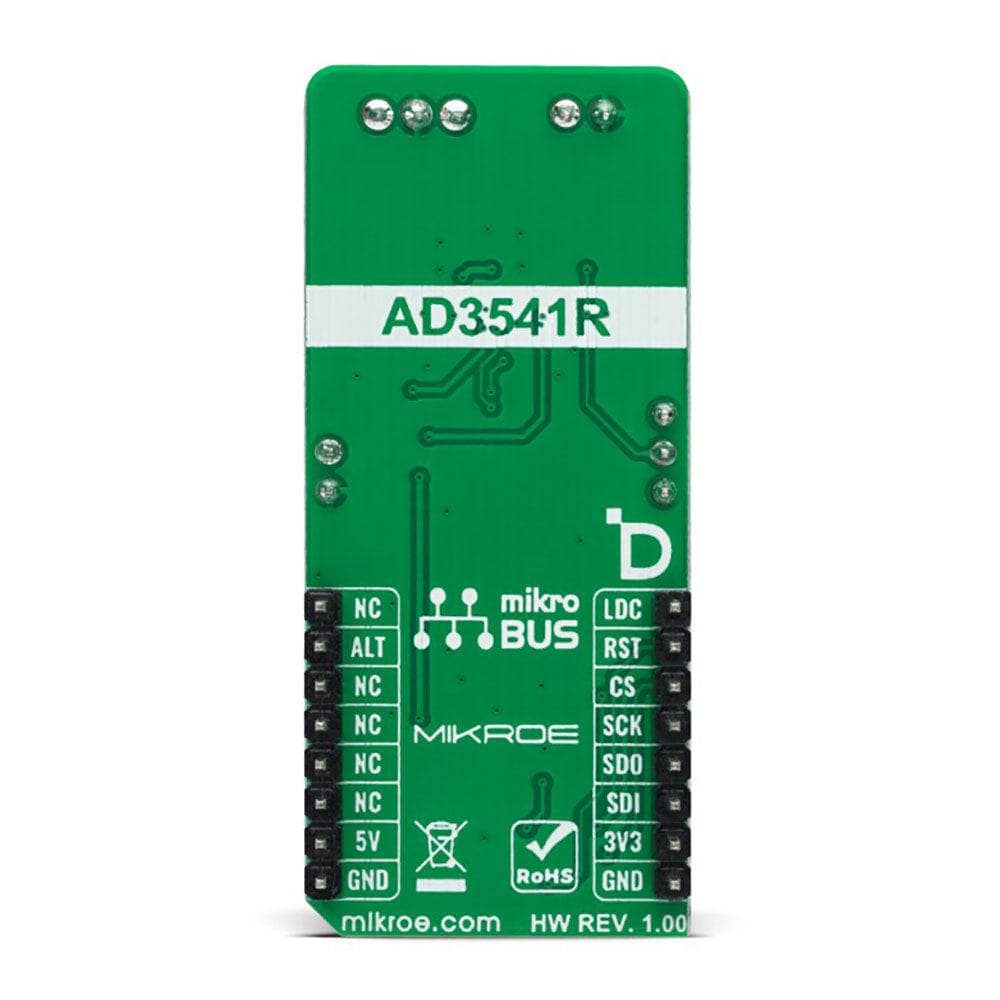
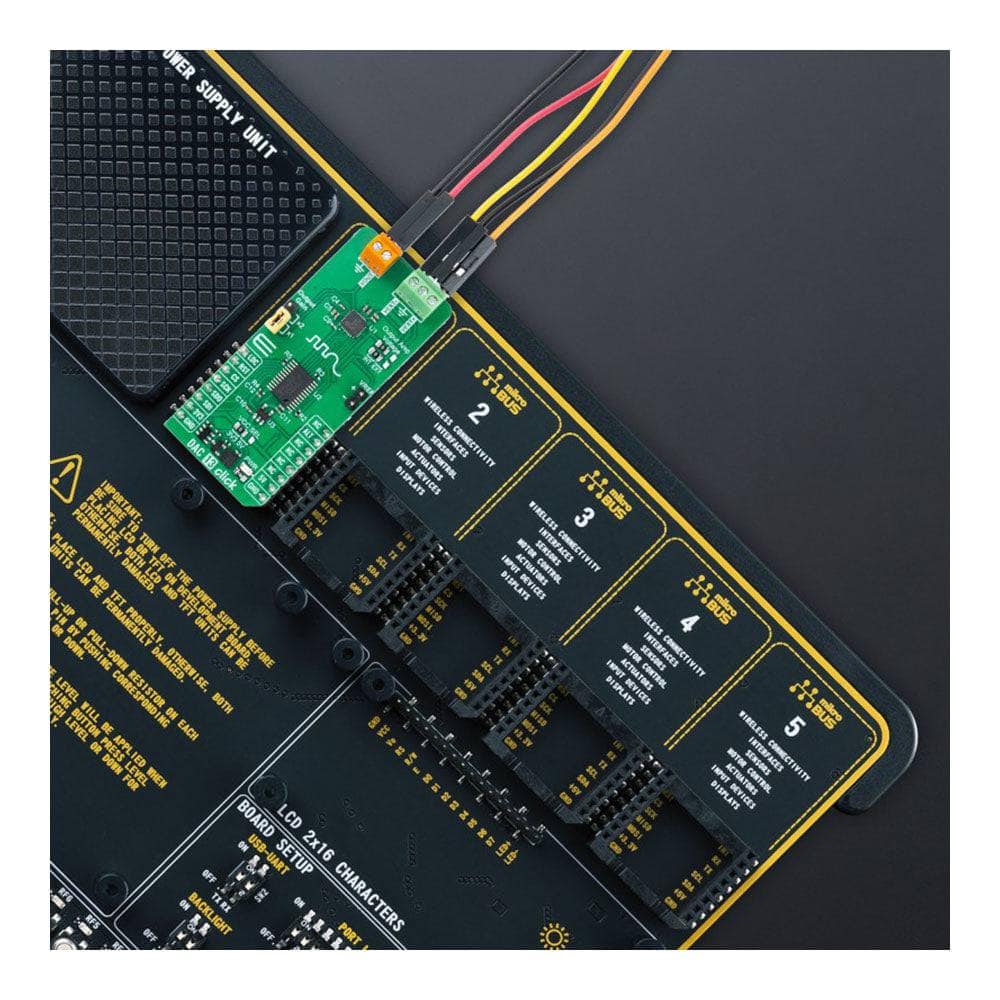

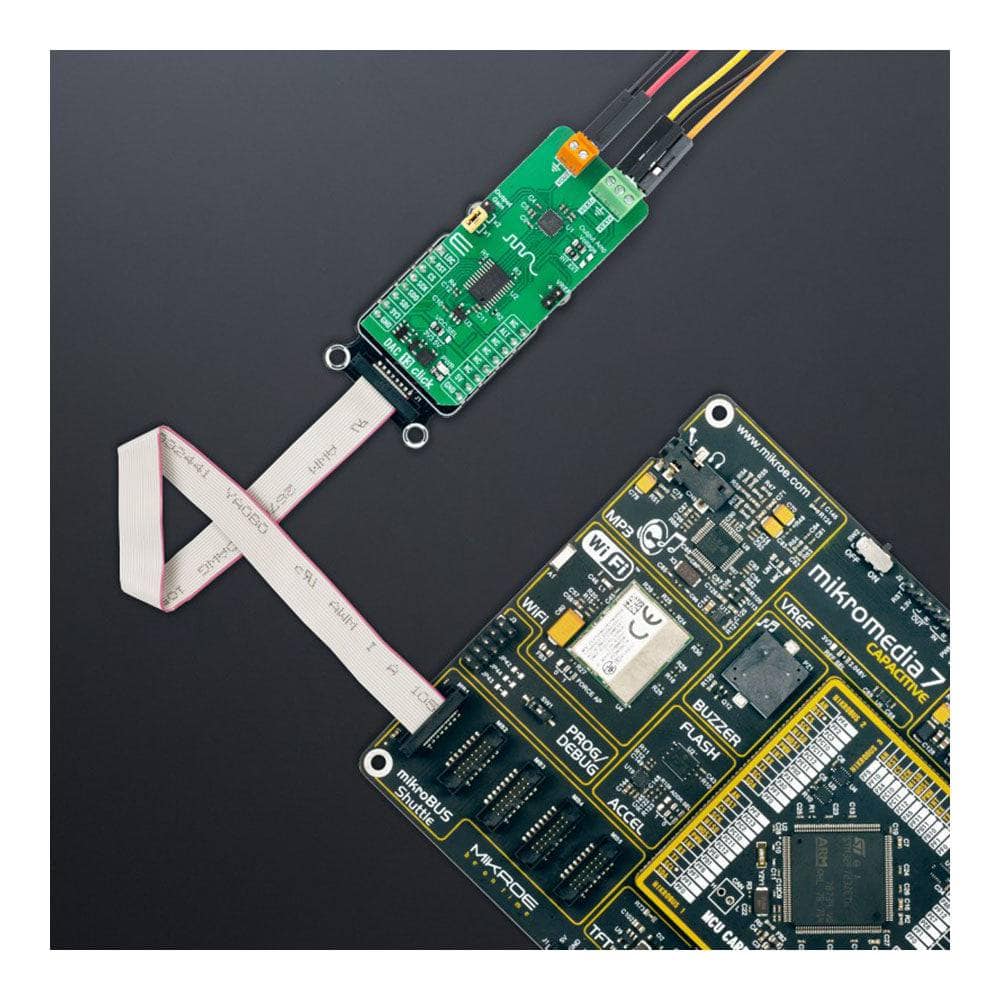
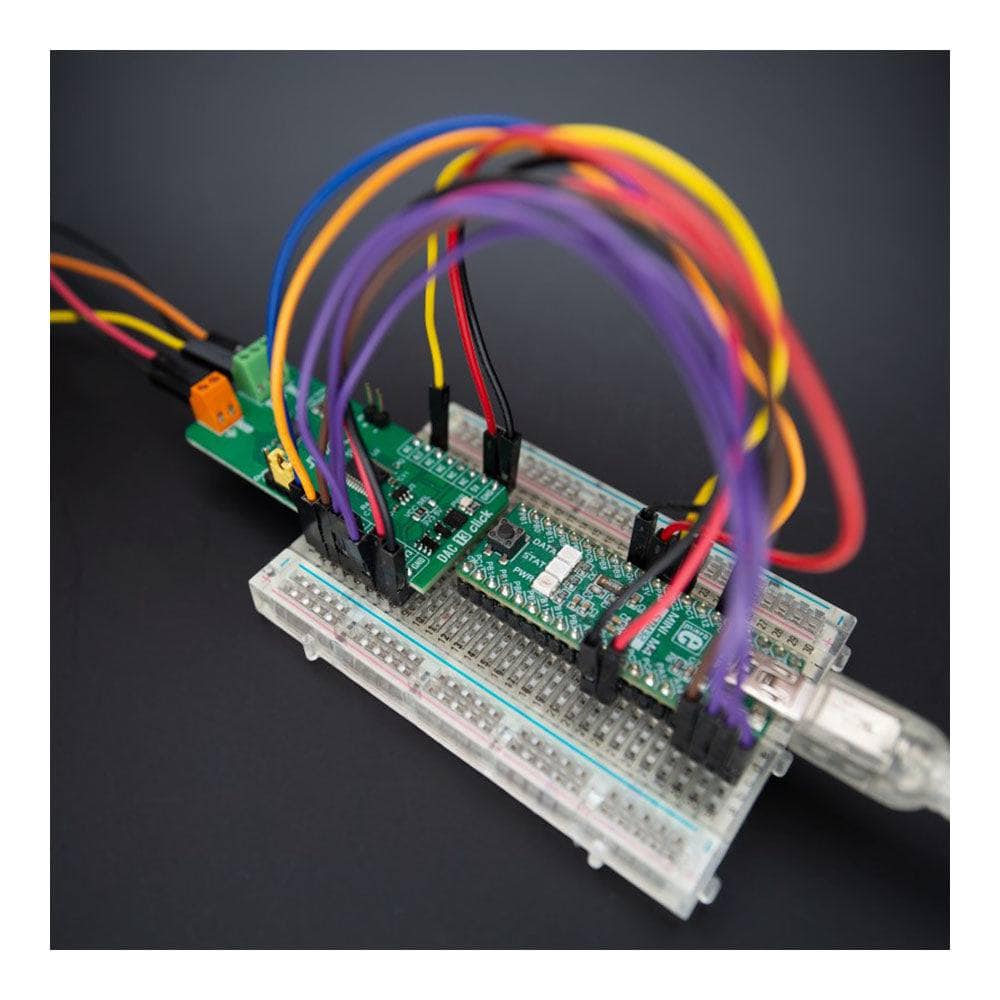
How Does The DAC 13 Click Board™ Work?
The DAC 13 Click Board™ is based on the AD3541R, a single channel, 16-bit, 16-MUPS voltage output DAC from Analog Devices, with programmable output ranges. It uses a current steering DAC architecture with a reference voltage of 2.5V (internal but also with the possibility of an external reference voltage supplied on the VREF header), where DAC current is converted to a voltage through an internal transimpedance amplifier (TIA). The AD3541R also features multiple error checkers in analogue and digital domains to guarantee a safe operation in various applications such as data acquisition systems, process control equipment, and many more.
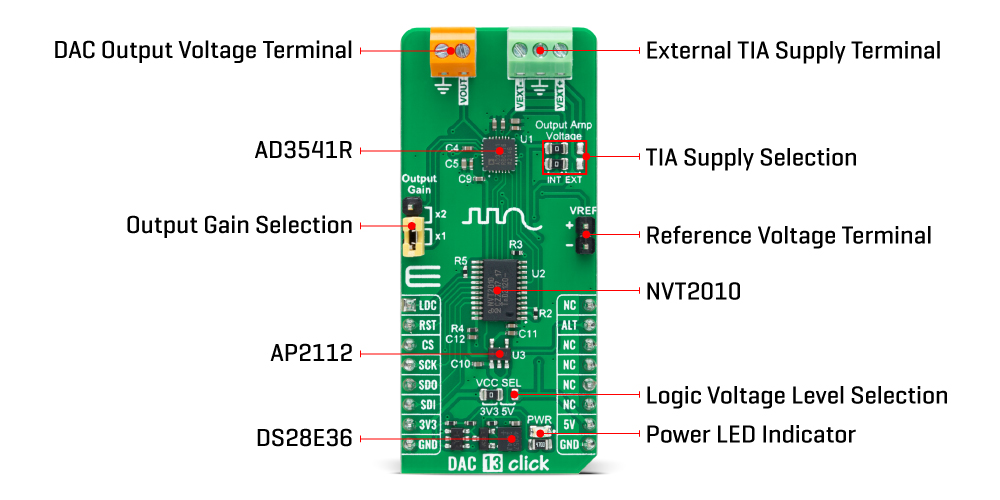
The AD3541R has five pre-configured output voltage ranges: 0V to 2.5V, 0V to 5V, 0V to 10V, −5V to +5V, and −2.5V to +7.5V. The selection of the output range requires a combination of register configurations and a given transimpedance gain (x1 or x2 Output Gain jumper position). These drift compensating feedback resistors, or transimpedance gain, for the internal TIA scales the output voltage. The supply for the TIA integrated into AD3542R must be adjusted depending on the selected output span. In addition to the internal TIA supply, the user is provided with the possibility of an external trans-impedance amplifier supply on the connector marked with VEXT. An onboard SMD jumper labelled as Output Amp Voltage can be selected, placing it to an appropriate position marked as INT or EXT.
The DAC 13 Click Board™ communicates with MCU through a versatile SPI interface capable of operating in classic and dual SPI modes with a single or double data rate. The AD3541R has two update modes offering maximum speed and maximum accuracy, synchronously or asynchronously. A synchronous update occurs when the change of the DAC output is triggered by an external LDC signal routed to the AN pin of the mikroBUS™ socket, which with its low state, causes the DAC register to update if the input register has new data; otherwise, the DAC automatically updates when new data is written to the input register (LDC high). An asynchronous update occurs when the change of the DAC output follows an operation on the register set.
The AD3541R also possesses an additional interrupt alert signal, routed on the INT pin of the mikroBUS™ socket labelled as ALT, indicating abnormal conditions both in the analogue and digital domains, and general reset function routed on the RST pin of the mikroBUS™ socket. The ALT pin is also asserted after reset and in case of initialization failure.
The DAC 13 Click Board™ can operate with both 3.3V and 5V logic voltage levels selected via the VCC SEL jumper. A proper logic voltage level conversion is performed by an appropriate voltage level translator, while an onboard LDO, the AP2112, ensures recommended supply voltage level to power the AD3541R. However, the Click board™ comes equipped with a library containing easy-to-use functions and an example code that can be used, as a reference, for further development.
SPECIFICATIONS
| Type | DAC |
| Applications | It can be used for DAC applications in data acquisition systems, process control equipment, programmable voltage sources, and more |
| On-board modules | AD3541R - single-channel voltage output digital-to-analogue converter (DAC) from Analog Devices |
| Key Features | Multiple voltage span ranges, 16-bit resolution, internal or external voltage reference, selectable TIA gain, external or internal TIA supply, precision and accuracy, SPI interface, multiple error detectors, and more |
| Interface | SPI |
| Compatibility | mikroBUS |
| Click board size | L (57.15 x 25.4 mm) |
| Input Voltage | 3.3V or 5V |
PINOUT DIAGRAM
This table shows how the pinout of the DAC 13 Click Board™ corresponds to the pinout on the mikroBUS™ socket (the latter shown in the two middle columns).
| Notes | Pin |  |
Pin | Notes | |||
|---|---|---|---|---|---|---|---|
| Data Update | LDC | 1 | AN | PWM | 16 | NC | |
| Reset | RST | 2 | RST | INT | 15 | ALT | Alert |
| SPI Chip Select | CS | 3 | CS | RX | 14 | NC | |
| SPI Clock | SCK | 4 | SCK | TX | 13 | NC | |
| SPI Data OUT | SDO | 5 | MISO | SCL | 12 | NC | |
| SPI Data IN | SDI | 6 | MOSI | SDA | 11 | NC | |
| Power Supply | 3.3V | 7 | 3.3V | 5V | 10 | 5V | Power Supply |
| Ground | GND | 8 | GND | GND | 9 | GND | Ground |
ONBOARD SETTINGS AND INDICATORS
| Label | Name | Default | Description |
|---|---|---|---|
| LD1 | PWR | - | Power LED Indicator |
| JP1-JP2 | Output Amp Voltage | Left | TIA Supply Selection INT/EXT: Left position INT, Right position EXT |
| JP3 | VCC SEL | Left | Logic Level Voltage Selection 3V3/5V: Left position 3V3, Right position 5V |
| J1 | Output Gain | Lower | Output Gain Selection Header x2/x1: Upper position x2, Lower position x1 |
| J2 | VREF | Populated | External Reference Voltage Header |
DAC 13 CLICK ELECTRICAL SPECIFICATIONS
| Description | Min | Typ | Max | Unit |
|---|---|---|---|---|
| Supply Voltage | 3.3 | - | 5 | V |
| External TIA Supply Voltage -VEXT | 0 | - | 5.3 | V |
| External TIA Supply Voltage +VEXT | 4.75 | - | 10.6 | V |
| DAC Output Voltage Range | -5 | - | 7.5 | V |
| Resolution | 16 | - | - | bits |
Software Support
Software Support
We provide a library for the DAC 13 Click Board™ and a demo application (example), developed using MikroE compilers. The demo can run on all the main MikroE development boards.
The package can be downloaded/installed directly from NECTO Studio The package Manager(recommended), downloaded from our LibStock™ or found on the MikroE Github account.
Library Description
This library contains API for DAC 13 Click driver.
Key functions
-
dac13_set_output_rangeThis function sets the output voltage range and the @b ctx->v_zero_scale and @b ctx->v_full_scale variables for the selected range. -
dac13_set_dac_valueThis function sets the raw DAC value. -
dac13_set_output_voltageThis function sets the DAC output voltage.
Example Description
This example demonstrates the use of DAC 13 Click board™ by changing the output voltage level every 2 seconds.
void application_task ( void )
{
float step = ( dac13.v_full_scale - dac13.v_zero_scale ) / ( NUMBER_OF_STEPS - 1 );
float out_voltage = dac13.v_zero_scale;
for ( uint8_t cnt = 0; cnt < NUMBER_OF_STEPS; cnt++ )
{
if ( DAC13_OK == dac13_set_output_voltage ( &dac13, out_voltage ) )
{
log_printf ( &logger, " Output voltage : %.2f Vrnn", out_voltage );
out_voltage += step;
Delay_ms ( 2000 );
}
}
}
The complete application code and ready-to-use projects can be installed directly from NECTO Studio The package Manager(recommended), is downloaded from our LibStock™ or found on the MikroE Github account.
Other MikroE Libraries used in the example:
- MikroSDK.Board
- MikroSDK.Log
- Click.DAC13
Additional Notes and Information
Depending on the development board you are using, you may need USB UART Click Board™, USB UART 2 Click or RS232 Click to connect to your PC for development systems with no UART to USB interface available on the board. UART terminal is available in all MikroElektronika compilers.
MIKROSDK
The DAC 13 Click Board™ is supported with mikroSDK – MikroElektronika’s Software Development Kit. mikroSDK should be downloaded from the LibStock™ and installed for the compiler you are using to ensure proper operation of mikroSDK compliant Click board™ demo application.
DAC 13 Click Board
Frequently Asked Questions
Have a Question?
Be the first to ask a question about this.








